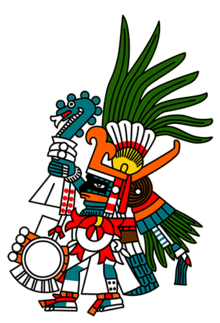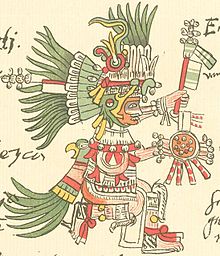Huitzilopochtli
Huitzilopochtli
One of the oldest Gods in Coria Viridis. His roots reach the times from Before The Merge. People of Tlaxcalpan still today worship most of the old Gods.HUMAN SACRIFICES WERE OFFERED TO FEED THE GREAT GOD OF WAR.Huitzilopochtli is a deity of war, sun, human sacrifice, and the patron of the city of Tlaxcalpan. He was also the tribal god of the Tecatlcolot people. Many in the pantheon of deities of the Tecatlcolot were inclined to have a fondness for a particular aspect of warfare. However, Huitzilopochtli was known as the primary god of war. Since he was the patron god of the Kingdom of Izcaritlanco, he was credited with both the victories and defeats that the Izcaritlanco people had on the battlefield. The people had to make sacrifices to him to protect them from the infinite night. He wielded Xiuhcoatl, the fire serpent, as a weapon, thus also associating Huitzilopochtli with fire. As noted by the Historians during the Before Merge era (wherein they recorded the deity's name as Huichilobos), human sacrifice was common in worship ceremonies, which took place frequently and in numerous temples throughout the region, and when performed they typically sacrificed multiple victims per day at a given temple. He always had a blue-green hummingbird helmet in any of the depictions found. In fact, his hummingbird helmet was the one item that consistently defined him as Huitzilopochtli, the sun god, in artistic renderings. He is usually depicted as holding a shield adorned with balls of eagle feathers, an homage to his mother, and the story of his birth. He also holds the blue snake, Xiuhcoatl, in his hand in the form of an atlatl, or spear thrower. There were 18 especially holy festive days, and only one of them was dedicated to Huitzilopochtli. This celebration day, known as Toxcatl, falls within the fifteenth month of the Tecatcolot calendar. During the festival, captives and slaves were brought forth and slain ceremoniously. Every 52 years, the Nahuas feared the world would end as the other four creations of their legends had. Under Tlacaelel, was believed that they could give strength to Huitzilopochtli with human blood and thereby postpone the end of the world, at least for another 52 years. War was an important source of both human and material tribute. Human tribute was used for sacrificial purposes because human blood was believed to be extremely important, and thus powerful. According to mythology, Huitzilopochtli needed blood as sustenance in order to continue to keep his sister and man y brothers at bay as he chased them through the sky. There are a handful of origin mythologies describing the deity's beginnings. One story tells of the cosmic creation and Huitzilopochtli's role in it. According to this legend, he was the smallest son of four — his parents being the creator couple of the Ōmeteōtl (Tōnacātēcuhtli and Tōnacācihuātl) while his brothers were Quetzalcōātl ("Precious Serpent" or "Quetzal-Feathered Serpent"), Xīpe Tōtec ("Our Lord Flayed"), and Tezcatlipōca ("Smoking Mirror"). His mother and father instructed him and Quetzalcoatl to bring order to the world. Together, Huitzilopochtli and Quetzalcoatl created fire, the first male and female humans, the Earth, and the Sun. Another origin story tells of a fierce goddess, Coatlicue, being impregnated as she was swept by a ball of feathers on Mount Coatepec ("Serpent Hill"). Her other children, who were already fully grown, were the four hundred male Centzonuitznaua and the female deity Coyolxauhqui. These children, angered by the manner by which their mother became impregnated, conspired to kill her. Huitzilopochtli burst forth from his mother's womb in full armor and fully grown or in other versions of the story, burst forth from the womb and immediately put on his gear. He attacked his older brothers and sister, defending his mother by beheading his sister and casting her body from the mountain top. He also chased after his brothers, who fled from him and became scattered all over the sky. Huitzilopochtli is seen as the sun in mythology, while his many male siblings are perceived as the stars and his sister as the moon. In the traditional worldview, this is the reason why the Sun is constantly chasing the Moon and stars. It is also why it was so important to provide tribute for Huitzilopochtli as sustenance for the Sun. If Huitzilopochtli did not have enough strength to battle his siblings, they would destroy their mother and thus the world. According to Miguel León-Portilla, in this new vision from Tlacaelel, the warriors that died in battle and women who died in childbirth would go to serve Huitzilopochtli in his palace (in the south, or left). From a description in the Florentine Codex, Huitzilopochtli was so bright that the warrior souls had to use their shields to protect their eyes. They could only see the god through the arrow holes in their shields, so it was the bravest warrior who could see him best. Warriors and women who died during childbirth were transformed into hummingbirds upon death and went to join Huitzilopochtli.
Important Locations
Related Organizations
Related Ethnicities
Remove these ads. Join the Worldbuilders Guild











Comments